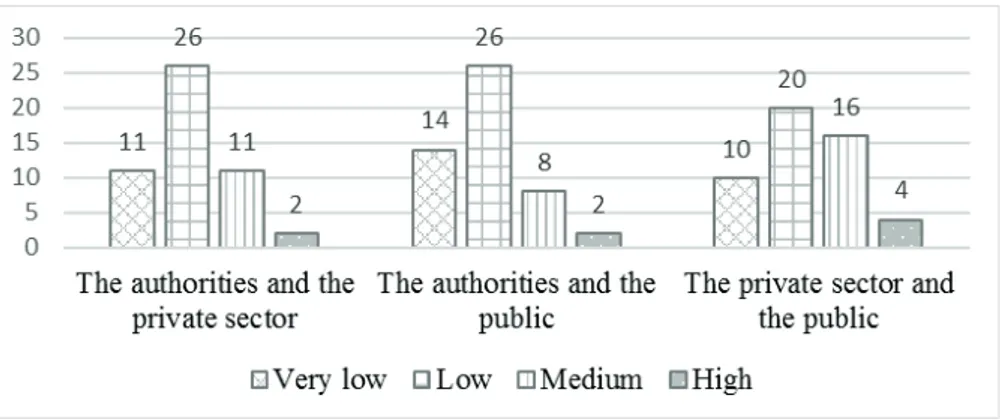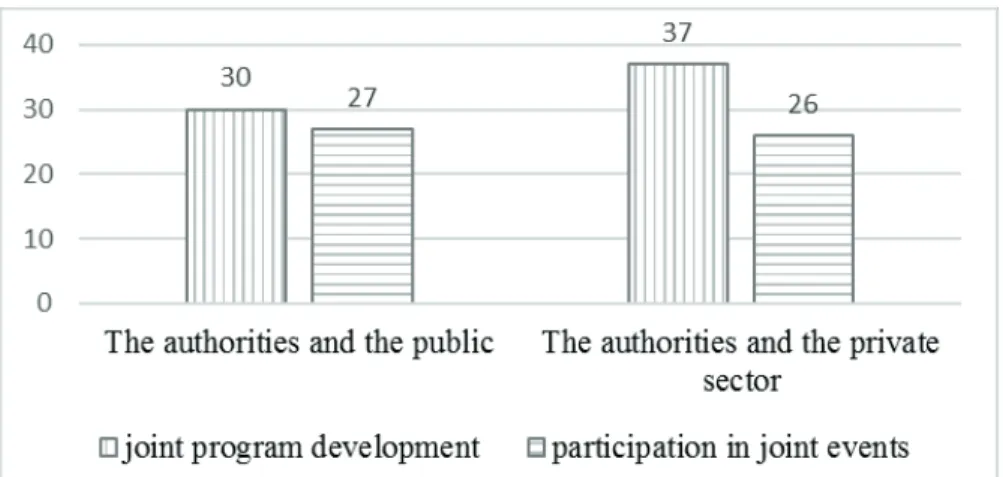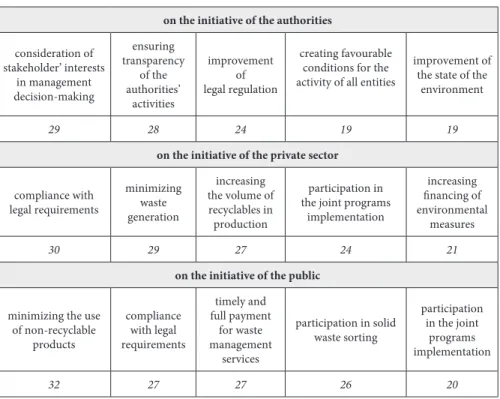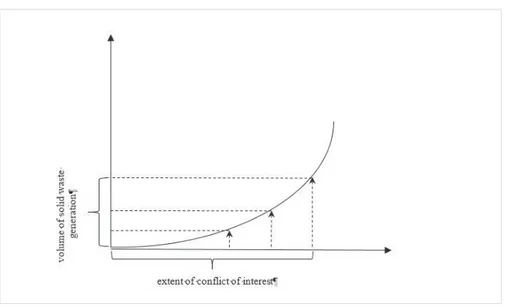AN ANALYSIS OF THE MECHANISMS FOR ESTABLISHING
COOPERATION BETWEEN PUBLIC AUTHORITIES,
THE PRIVATE SECTOR, AND THE PUBLIC IN DOMESTIC
WASTE MANAGEMENT IN UKRAINE
Igor DunayevKharkiv Regional Institute of Public Administration of the National Academy for Public Administration under the President of Ukraine;
75 Moskovsky Avenue, Kharkiv, 61050, Ukraine
Yurii Kuts
Kharkiv Regional Institute of Public Administration of the National Academy for Public Administration under the President of Ukraine;
75 Moskovsky Avenue, Kharkiv, 61050, Ukraine
Nataliya Stativka
Kharkiv Regional Institute of Public Administration of the National Academy for Public Administration under the President of Ukraine;
75 Moskovsky Avenue, Kharkiv, 61050, Ukraine
Olha Ziuz
Kharkiv Regional Institute of Public Administration of the National Academy for Public Administration under the President of Ukraine;
75 Moskovsky Avenue, Kharkiv, 61050, Ukraine
Viktoriia Kralia
Kharkiv Petro Vasylenko National Technical University of Agriculture 44 Alchevskikh Street, Kharkiv, 61002, Ukraine
DOI: 10.13165/VPA-20-19-2-12
an expert survey on determining the prospects for improving the state of SWM through the use of mechanisms for establishing cooperation between the authorities, the private sector, and the public. The findings provided information that is useful for identifying the major barriers that prevent the authorities, the private sector, and the public from collaborating in SWM, as well as for setting the criteria for estimating the efficiency of cooperation be-tween these entities. Furthermore, in the course of the study, a hypothesis was formulated: that the crisis determinants of SWM stem from conflicts of interest between the authorities, the private sector, and the general public.
Keywords: public administration, waste management, mechanism, partnership, sphere of SWM, Ukraine
Raktiniai žodžiai: viešasis administravimas, kietųjų buitinių atliekų tvarkymas, mechanizmas, partnerystė, Ukraina
JEL: Q56, O44, R58, R50
Introduction
The current state of world public administration is characterized by a shift in its pri-orities towards addressing environmental concerns. In this respect, Ukraine, whose state environmental policy is at the point of bifurcation, is no exception. Ukraine tends to degrade its untapped environmental potential, which is manifested in environmental pollution due to solid domestic wastes. It is noteworthy that current financial, economic, and technological problems do not fully reflect the destruction being wrought on the environment, as they mainly refer to communication within the ‘authorities – private sector – public’ triad.
Today’s reality is that the transition in Ukraine towards market conditions is accom-panied by an increased shadowing of the private sector, and the unwillingness of the population to accept the new utility tariff policy. The instability and uncertainty in re-gards to the vectors of national development, and an increasing dependence of the state on external factors, strengthen the influence of destabilizing factors on any progress in environmental protection. The sphere of SWM in Ukraine is at the point of confronta-tion between the authorities, the private sector, and the public, given both the imbalance in state environmental policy and the deteriorating environment.
Literature review
In 2015, the international community identified the global priorities for sustainable development by 2030 (G20 2016), according to which developed and developing coun-tries must meet a set of 17 goals. One of the objectives (number 17) aims to use the proven practices of forging different forms of partnership, which requires a considerable administrative capacity, an appropriate legal framework, a high corporate social respon-sibility, and years of experience (Aizawa 2018, 7; ECA 2018, 11; Smaliukienė 2005, 69).
In Ukraine, studies on the mechanisms for cooperation between the authorities, the private sector, and the public are only starting to gain traction. Scientists are highlighting aspects of establishing cooperation, one of the most common forms of which is public-private partnership (PPP). Despite a comprehensive PPP regulatory framework, this sec-tor in Ukraine faces a number of problems regarding the transparency of government ac-tivities, the lack of publicly available project registers and the complexity of their prepa-ration, and a dependence on budget fluctuations (Khodakivska and Mohylnyi 2018, 535; Verkhovna Rada of Ukraine 2010; The EIU 2017, 46). In the 2009 business environment rating, Ukraine ranked 72nd among 82 countries (The EIU 2019).
In today’s world, there exist different approaches to determining the best forms of cooperation, in particular the European and Asian methods. The Asian partnership model is dependent on the government coordination of relationships with other actors for a proper implementation of policies and supply of resources, while examples of the European partnership demonstrate the strong role of the private sector in achieving sus-tainable development (Marx 2019, 2). As noted by Abbott, Levi-faur, and Snidal (2017), the private sector has all the necessary resources, experience, and knowledge sufficient to enforce the law. The result of a partnership is an optimum sharing of risk with the private partner, and keeping the price–quality ratio affordable to both the public sector and consumers (MOVECO 2018, 10; Paresashvili and Abashishvili 2013; Raisiene 2010).
At the same time, to establish a partnership, it is necessary that the efforts of the parties are directed not only at solving problems related to economic growth, but also at gains in welfare for all the population strata and improvement of the living condi-tions in the country as a whole (Jakunin 2007). Experts indicate the following success criteria for this form of partnership: jointly developed goals and objectives on a ‘benefit to everyone – benefit to all’ basis; action plan approval by all partners; and a high level of trust between partners (Androniceanu and Tvaronavičienė 2019, 107; Butova et al. 2014; Stasova 2012). In this case, it is advisable to take into account not only the authorities and the private sector, but also the population as an aggregate of inhabitants of a certain terri-tory who are carriers of certain local interests (Dunayev and Ziuz 2019, 109).
interests), as the most problematic aspect in the relationship between the authorities and the population is a lack of trust in the state power (Dunayev 2017, 199). Despite the prevalence of bilateral partnership models, it is important to involve all the stakeholders, which is expressed in cooperation and finding an interest common to the authorities, the private sector, and the public.
Research methodology
Aiming to obtain the necessary data, an expert survey was conducted on the theme of ‘The prospects of improving the status of SWM through the use of mechanisms for establishing cooperation between the authorities, the private sector, and the public’ in August–September 2019.
The purpose of the study was to analyse the state of the mechanisms for establishing cooperation between the authorities, the private sector, and the public in the field of SWM. The main task was to identify the obstacles to cooperation between the authori-ties, the private sector, and the public, as well as to determine the criteria for assessing the efficiency of cooperation between these entities in the field of solid domestic waste management.
The selected methods of the study were: a sociological survey – for interviewing the SWM professionals with the relevant experience and competence; and modelling – for developing a model of relationships between the authorities, the private sector, and the public in the SWM sphere. Public administration and local government officials and the staff of executive bodies, representatives of the private sector and NGOs, and research-ers and educators acted as respondents. The total number of respondents was n = 50, including women (48%) and men (52%), living in cities with a population of more than 50,000 residents (86%), villages/settlements (8%), and cities with a population of less than 50,000 residents (6%). The largest age groups were: 31–35 years (16%); 36–40 years (20%); and 41–45 years (20%). In terms of education, 20% of respondents had a PhD/ Doctor of Science degree.
Analysis of the research results and main findings
The questions of the poll were divided into specific blocks, the first of which con-cerned the assessment of the status of SWM in Ukraine in general. According to the respondents, the state of the environment is ‘rather unsatisfactory’ (50%) or ‘unsatisfac-tory’ (20%), which indicates the inefficiency of the state policy that negatively affects the environmental situation in the regions. 92% of the respondents pointed to the problem of contaminated areas in their places of residence. 58% of the respondents termed the state of SWM in Ukraine as ‘unsatisfactory’, while 36% agreed to an assessment of ‘rather unsatisfactory’. Only 4% of the respondents rated the current state of SWM as ‘rather satisfactory’. However, none of the experts chose the ‘satisfactory’ rating for the state of SWM.
The questions in the next block assessed the efficiency of cooperation between the authorities, the private sector, and the public in the field of SWM (Fig. 1). According to the experts, the level of cooperation between these entities is ‘very low’ and ‘low’. It should be emphasized that the efficiency of cooperation between the private sector and the public is medium, i.e. in some aspects of SWM the private sector and the population manage to maintain a certain level of interaction, as shown below. None of the experts chose the option of ‘very high’ for the cooperation between the authorities, the private sector, and the general public.
Fig. 1. How do you assess the efficiency of cooperation between the authorities, the private sector, and the public in the field of SWM in Ukraine?
(24). Some of the experts also gave their own answers, specifically noting the ‘absence of an effective, economically sound model of SWM’.
The survey provided questions about PPP and suggested assessing the extent to which this mechanism promotes synergies between the authorities, the private sector, and the public in the field of SWM in Ukraine (Fig. 2). The majority of the respondents agreed with the view that the mechanism is ‘unlikely to contribute’ (15) to achieving cooperation. On the contrary, some experts believe that this mechanism ‘definitely con-tributes’ (8) or ‘rather concon-tributes’ (6) to the achievement of cooperation between these entities. However, a significant number of experts were ‘not able to answer the question unequivocally’ (10), indicating insufficient legal regulation of the functioning of the PPP mechanism.
Fig. 2. To what extent does the PPP mechanism contribute to cooperation between the authorities, the private sector, and the public in the sphere of SWM in Ukraine?
Concerning the definition of the basic principles of cooperation between the authori-ties, the private sector, and the public in SWM (Fig. 3), the experts noted the impor-tant role of local public authorities, responding that ‘the authorities should stimulate the private sector to solve the SWM problem’ (19), and ‘the authorities should take care of solving the problem of SWM, but the private sector should help, too’ (15). A similar principle works in relations between the authorities and the population, hence approval of: ‘the authorities should take care of the problem of SWM, but the citizens should also help’ (27). In the opinion of some experts (9), ‘the authorities should encourage citizens to solve SWM problems’. None of the respondents chose to select the option ‘citizens should take initiative in solving the problem of SWM’.
performing a control function, and collecting statistics’; and ‘the authorities must create the framework conditions for the SWM system’. Additionally, ‘the authorities should get the private sector and the population involved in cooperation’ was frequently (25) noted. Some respondents also supported the view that ‘the private sector and the public should interact through the authorities’ (11).
Fig. 3. The major principles of cooperation between the authorities, the private sector, and the public in the field of SWM
Fig. 4. The most effective forms of cooperation between the authorities, the private sector, and the public in SWM
Table 1. In what way can cooperation between the authorities, the private sector, and the public be enhanced in the field of SWM?
on the initiative of the authorities
consideration of stakeholder’ interests in management decision-making ensuring transparency of the authorities’ activities improvement of legal regulation creating favourable conditions for the activity of all entities
improvement of the state of the
environment
29 28 24 19 19
on the initiative of the private sector
compliance with legal requirements minimizing waste generation increasing the volume of recyclables in production
participation in the joint programs
implementation
increasing financing of environmental
measures
30 29 27 24 21
on the initiative of the public
minimizing the use of non-recyclable products compliance with legal requirements timely and full payment for waste management services
participation in solid waste sorting
participation in the joint
programs implementation
32 27 27 26 20
Fig. 5. What, in your opinion, can serve as a criterion for the assessment of cooperation between the authorities, the public sector, and the public in SWM?
Given the expert survey results, the level of efficiency of the cooperation between the authorities and the private sector in the field of SWM in Ukraine is low. Along with this, there exist conflicts of interests and mutual distrust between the entities, which causes SWM problems. Thus, taking into account the above data, it can be asserted that the hy-pothesis of the study about the determinants of the crisis state of SWM being dependent on the conflict of interests between the authorities, the private sector, and the public has been proved correct. It follows that the problem of SWM depends on the state of rela-tions between the authorities, the private sector, and the public, i.e. a specific feature of the current stage in the development of SWM is that the problem of waste is the result of a poor interaction in the ‘authorities – private sector – population’ chain. There has been a direct correlation observed between solid domestic waste generation (entailing environmental deterioration) and the intensification of the conflict of interests between the authorities, the private sector, and the public (Fig. 6).
Fig. 6. Correlation between the volumes of solid domestic waste generation and the extent of conflict of interests
Conclusions
1. The results of the study showed that in Ukraine there is a ‘rather unsatisfactory’ and ‘unsatisfactory’ state of SWM, which is caused by an ineffective state policy in the sphere, with 92% of respondents saying that in their settlement there is a problem of contamination of the territory with solid domestic wastes.
2. The findings indicate that the effectiveness of interaction between the authorities, the private sector, and the public in the area of SWM is low. The main obstacles to achiev-ing effective interaction between these entities are: inadequate legislative regulation, corruption, low public awareness of governance mechanisms, lack of transparency in management decision-making, and mutual mistrust.
3. The mechanism of public-private partnership is rather non-conducive to achieving interaction between the authorities, the private sector, and the population, which indi-cates the urgency of further legislative regulation of the functioning of this mechanism. 4. Regarding the definition of the basic principles of interaction between the authorities,
the private sector, and the public in the field of SWM, the role of government represen-tatives is significant, since they should stimulate the private sector and the population to cooperate and solve the SWM problem through the development of joint programs, participation in joint events, and the creation of a joint consultative and advisory body. 5. The criteria for assessing the interaction between the authorities, the private sector, and
consequences of the implementation of partnership agreements; the number of people engaged in the sorting of SWM; volumes of recyclable products; and the condition of public health.
6. A direct dependence is observed between solid domestic waste production (and envi-ronmental degradation as its consequence) and the intensification of conflicts of inter-ests between the public authorities, the private sector, and the general public. In order to counteract this conflict of interests, it is necessary to strengthen cooperation between these entities through the development of joint programs and participation in joint activities towards the achievement of the goal of public administration in the field of SWM. Efforts should be made to improve the legal regulation, to ensure transparency of the authorities’ activity, to create favourable conditions for the activities of all actors, and to take into account the interests of stakeholders when making management deci-sions.
References
1. Abbott, K. W., Levi-faur, D., and Snidal, D. 2017. “Theorizing Regulatory Intermediar-ies.” The Annals of the American Academy of Political and Social Science 670: 14–35. https://doi.org/10.1111/rego.12030.
2. Aizawa, M. 2018. “A Scoping Study of PPP Guidelines.” DESA Working Paper No. 154. http://www.un.org/esa/desa/papers/2018/wp154_2018.pdf.
3. Androniceanu, А., and Tvaronavičienė, M. 2019. “Developing a Holistic System for Social Assistance Services Based on Effective and Sustainable Partnerships.” Admin-istratie Si Management Public [Public Administration and Management] 33: 103–18. https://doi.org/10.24818/amp/2019.33-06.
4. Butova, T. V., Dunaeva, A. I., and Udachin, N. O. 2014. “Models of Interaction of Pow-er and Business in the Russian FedPow-eration.” Vestnilk univPow-ersiteta [UnivPow-ersity HPow-erald] 6: 23–26.
5. Dunayev, I. V. 2017. Public Regional Economic Policy in Ukraine: Shaping of Modern-ization Mechanisms. Kharkiv: Magister.
6. Dunayev, I. V., and Ziuz, О. S. 2019. “Establishing a Partnership with the Local Pop-ulation in Resolving the Problems in Solid Domestic Waste Management.” Aktualni problemy derzhavnogo upravlinnya [Actual Problems of Public Administration] 1 (55): 108–18.
7. ECA (European Court of Auditors). 2018. Public Private Partnerships in the EU: Wide-spread Shortcomings and Limited Benefits. Luxembourg: ECA. https://www.eca.europa. eu/Lists/ECADocuments/SR18_09/SR_PPP_EN.pdf.
8. The EIU (Economist Intelligence Unit). 2017. Evaluating the Environment for Public-Private Partnerships in Eastern Europe, Central Asia and the Southern and Eastern Mediterranean: The 2017 Infrascope. London: The EIU.
10. G20. 2016. Action Plan on the 2030 Agenda. https://www.g20.org/Content/DE/_Anla-gen/G7_G20 /2016-09-08-g20-agendaactionplan.pdf.
11. Jakunin, V. I. 2007. “Partnerstvo v mehanizme gosudarstvennogo upravlenija [Partner-ship in the Mechanism of Public Administration.” Sociologicheskie issledovanija [Socio-logical Studies] 2: 5-23.
12. Khodakivska, O. and Mohylnyi, O. 2018. “The Modern State of Agricultural Policy of Ukraine: Problems of Countries with Transition Economy.” Public Policy and Admin-istration 17 (4): 526–38. https://doi.org/10.13165/VPA-18-17-4-03.
13. Marx, А. 2019. “Public-Private Partnerships for Sustainable Development: Exploring Their Design and Its Impact on Effectiveness.” Sustainability 11 (4): 1087. https://doi. org/10.3390/su11041087.
14. MOVECO. 2018. Circular Economy Innovation Tools Report on PPP-Investment Op-portunities. http://www.interreg-danube.eu/uploads/media/approved_project_out-put/0001/20/e49d64d468a233c18aef37754dfe7da593d5bb36.pdf.
15. Paresashvili, N., and Abashishvili, A. 2013. “Policy Implementation of the Eastern Partnership in Georgia.” Public Policy and Administration 12 (4): 633–43. https://doi. org/10.13165/VPA-13-12-4-09.
16. Raisiene, A. G. 2010. “Conceptualization of Inter-Organizational Partnership Struc-tural Model in Local Government.” Public Policy and Administration 34 (1): 107–21. 17. Rong, Zh., and Yalong, J. 2018. “The Evaluation of PPP Mode of Environmental
Pollu-tion PrevenPollu-tion and Control Based on the View of the Perspective of Sustainable De-velopment.” IOP Conference Series: Earth and Environmental Science 178 (1): 012003. https://doi.org/10.1088/1755-1315/178/1/012003.
18. Smaliukienė, R. 2005. “Viešojo ir privataus sektorių bendradarbiavimo įtaka socialinei atsakomybei versle. [The Impact of Public-Private Partnerships on Social Responsibil-ity in Business].” Viešoji politika ir administravimas [Public Policy and Administration] 1 (12): 69–76.
19. Stasova, T. M. 2012. The Relationship between Business and the State: Theoretical As-pects. Moscow: Kurs.
20. Verkhovna Rada of Ukraine. 2010. Law on Public-Private Partnership No. 2404-VI, 1 July 2010. http://zakon2.rada.gov.ua/laws/show/2404-17.
Igor Dunayev, Yurii Kuts, Nataliya Stativka, Olha Ziuz, Viktoriia Kralia
Valdžios institucijų, privačiojo sektoriaus ir gyventojų sąveikos
mechanizmų analizė kietųjų atliekų tvarkymo srityje Ukrainoje
Anotacija
Straipsnyje aptariama būtinybė ištirti valdžios institucijų, privačiojo sektoriaus ir visuomenės bendradarbiavimo kietųjų buitinių atliekų tvarkymo (toliau – KBA) srity-je kūrimo mechanizmus dabartinėmis sąlygomis Ukrainosrity-je. Trumpai apžvelgta tokios partnerystės formavimo praktika Ukrainoje ir pasaulyje. Siekiant nustatyti KBA būklės pagerėjimo perspektyvas naudojant valdžios, privačiojo sektoriaus ir visuomenės ben-dradarbiavimo užmezgimo mechanizmus, darbe kartu su teorine medžiaga pateikiami ekspertų apklausos rezultatai. Gauti rezultatai suteikė naudingos informacijos nustatant pagrindines kliūtis, trukdančias valdžios institucijoms, privačiajam sektoriui ir visuo-menei bendradarbiauti KBA srityje, taip pat nustatant šių subjektų bendradarbiavimo veiksmingumo vertinimo kriterijus. Tyrimo metu buvo suformuluota hipotezė, kad KBA krizę lemiantys veiksniai kyla iš valdžios, privačiojo sektoriaus ir visuomenės interesų konflikto.
Igor Dunayev – PhD in Public Administration, professor at the Department of Economic Policy and
Management at Kharkiv Regional Institute of Public Administration of the National Academy for Public Administration under the President of Ukraine
E-mail: Igor.dunayev@gmail.com orcid.org/0000-0002-0790-0496
Yurii Kuts – PhD in Public Administration, professor, head of Regional Development and Local
Self-Governance Department at the Kharkiv Regional Institute of Public Administration of the National Academy for Public Administration under the President of Ukraine
E-mail: koots.yuriy@gmail.com orcid.org/0000-0002-8629-012X
Nataliya Stativka – PhD in Public Administration, professor, head of Personnel Management and Labour
Economics Department at the Kharkiv Regional Institute of Public Administration of the National Academy for Public Administration under the President of Ukraine
E-mail: nstativka@ukr.net orcid.org/0000-0003-0903-6256
Olha Ziuz – postgraduate student at the Economic Policy and Management Department at the Kharkiv
Regional Institute of Public Administration of the National Academy for Public Administration under the President of Ukraine
Viktoriia Kralia – PhD in Economic Science, associate professor at the Department of Production, Business and Management Organisation at the Kharkiv Petro Vasylenko National Technical University of Agriculture
Е-mail: VKralya2905@gmail.com orcid.org/0000-0002-7442-790X
Igor Dunayev – Viešojo administravimo mokslų daktaras, Nacionalinės viešojo administravimo
akademijos prie Ukrainos prezidento Charkovo regioninio viešojo administravimo instituto Ekonominės politikos ir vadybos katedros profesorius
El. paštas: Igor.dunayev@gmail.com orcid.org/0000-0002-0790-0496
Yurii Kuts – Viešojo administravimo mokslų daktaras, profesorius, Nacionalinės viešojo administravimo
akademijos prie Ukrainos prezidento Charkovo regioninio viešojo administravimo instituto Regioninės plėtros ir vietos savivaldos katedros vedėjas
El. paštas: koots.yuriy@gmail.com orcid.org/0000-0002-8629-012X
Nataliya Stativka – Viešojo administravimo mokslų daktarė, profesorė, Nacionalinės viešojo
administravimo akademijos prie Ukrainos prezidento Charkovo regioninio viešojo administravimo instituto Personalo vadybos ir darbo ekonomikos katedros vedėja
El. paštas: nstativka@ukr.net orcid.org/0000-0003-0903-6256
Olha Ziuz – Nacionalinės viešojo administravimo akademijos prie Ukrainos prezidento Charkovo
regioninio viešojo administravimo instituto Ekonominės politikos ir vadybos katedros magistrantė El. paštas: nurgar@ukr.net
orcid.org/0000-0002-6208-5383
Viktoriia Kralia – Ekonomikos mokslų daktarė, Charkovo Petro Vasylenko nacionalinio technikos žemės
ūkio universiteto Gamybos, verslo ir vadybos organizavimo katedros docentė El. paštas: VKralya2905@gmail.com






